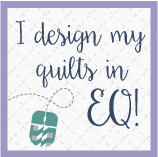

I frequently work with many of the fabric companies designing quilts to go with their new fabric collections. RJR is one of those companies that I do a lot of commission work for. They always have such beautiful fabrics that are easy to design with. In the beginning of the year they sent me a fabric collection called Family Roots which I immediately started playing with on my EQ8. I had been doing some sampler quilts with some previous companies (Soldier's Quilt) and collections so I thought I would try to do another one. I came upon with this concept. I love using log cabins in quilts and felt that this was an unusual setting that was different than other BOMs that I have seen.
RJR liked it and submitted the design to Missouri Star Quilt Company. They liked it too! So they picked it up and are selling it on their website. It is a nine month series and Missouri Star will be selling the kits each month for the next nine months. There are 13 fabrics in the quilt. Two of them come from a different fabric collection called Falls Majesty. You can purchase the first month's kit here: Hearth and Home BOM.
Each month you will receive the fabric in fat eighths, fat quarters or regular yardage to make the block(s) for that month. The pattern will include instructions for each block. To save me from having to print too many pages, I have designed cutting charts for each of the fabrics in pdf form. To receive the cutting charts you can use the contact form on this page to request them.
Each month I will be doing a short tutorial on piecing one or more of the blocks. If there is more than one technique that I will be discussing, I will divide it up into two or three separate tutorials. I will not be discussing cutting instructions or specific block piecing instructions. Those are in the pattern and you will have to purchase it with the kit if you want to make it.
To start off, before I talk about the blocks, I think it is important to discuss your 1/4" seam allowance. If you have not seen my Youtube video yet, here it is on how to establish an accurate 1/4" seam.
Because most of these blocks have numerous pieces, accuracy is very important. I always set my seam and make a test block with my own fabric. (You don't want to cut up the good fabric yet!) Measure each section for accuracy. It is easier to make adjustments at this level before sewing the parts together. Once you get that established you don't have to make any more test blocks. If you want to purchase my seam guide you can find it here: Perfect 1/4" Seam Guide.
Month 1 includes Blocks 1 and 2 and the connecting block (log cabin).



Block 1 has no special instructions. It is basically made of half-square and quarter square triangles sewn together. Just be sure to size up each section to the specifications of the pattern.
Block 2 has Half-Square triangles and Chevrons. The squares for the half-square triangles are cut slightly larger than needed so that once you piece them you can trim the patches down to size. You can either draw a line on the backs of the lighter fabric, sew 1/4" on each side of the line, cut apart and then trim the square to the size listed, or just cut them into triangles, sew them together and then trim it to the size listed. Don't be afraid of sewing on the bias. Just let the sewing machine do it's job and don't stretch the edge as you sew. I always add a pin at the end of the triangle so that the edges stay together when I sew it.
The Chevron patch is made with squares and rectangles. Again you can draw a line on the backs of the squares, sew on the line and then trim the seam to 1/4" or you can use my "Cutting Corners" template set to trim the corners and then sew with a 1/4" seam allowance. You can purchase my Cutting Corners template set here: Cutting Corners. It can be used a lot with the blocks in this quilt.
I'll save tips for the log cabin connecting block for the next blog.
DRAWING
As always, do what you love and love what you do. Thank you for reading and be sure to share this with your quilting friends. Toby.












































